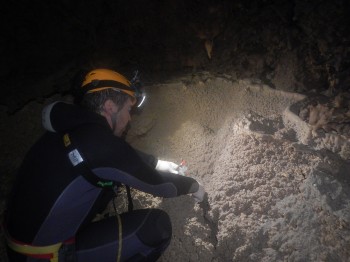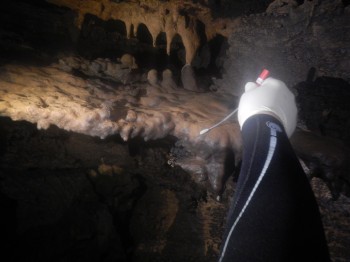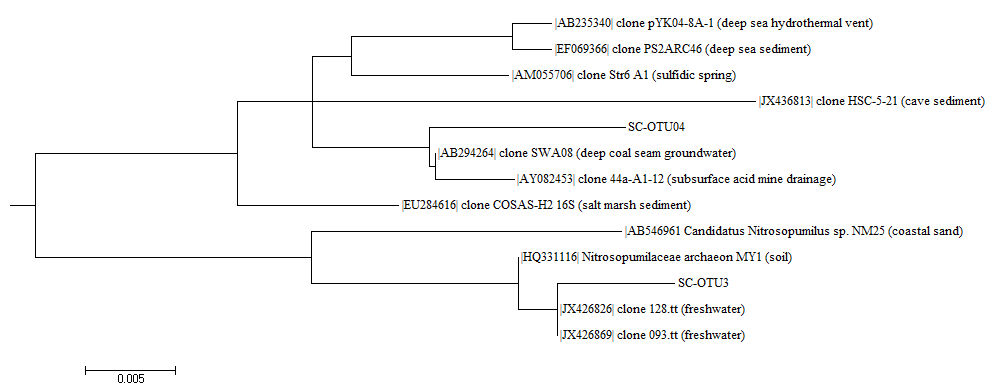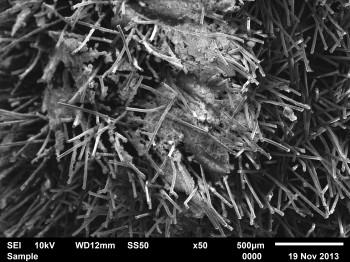
Astronauts on the 2013 CAVES expedition collect soil samples from the Sardinian caves. Credit: ESA/S.Leuko/L.Bessone
Without light to sustain plants, and the typical food chains we see on the Earth’s surface, the creatures that live underground need to be innovative in their search for fuel to survive. As a microbiologist, I am very interested in the question: what microbes live in a caves and how do they survive?
To be able to take samples in a cave, one must be highly trained and specialised and able to safely navigate through tight squeezes and labyrinthine tunnels to get to your sampling destination. In short, nothing an untrained lab rat like myself should attempt! But luckily for science, the ESA CAVES course sends 6 astronauts for 6 days into a cave with several tasks every year, one of which is microbiological sampling.

Astronauts on the 2013 CAVES expedition collect microbe swabs from the walls of the Sardinian caves. Credit: ESA/S.Leuko/L.Bessone
Life persists even in the most extreme environments on the surface of Earth. Consider the hot springs in Yellowstone or the arid Atacama Desert—the life forms that live here have evolved and adapted to a life in extreme conditions, in this case extreme heat and acidity. An extreme environment may also be lacking something. In underground environments the lack of sunlight and nutrients make a life in the dark an extreme one. Although microorganisms usually don’t need sunlight to thrive, more complex creatures do. Our curiosity about the way these organisms survive lead us to send experiments with the CAVES astronauts in 2013.
After we received the samples in 2013 (mud and dirt from the floor of the cave, and swabs from the cave walls), we used DNA extraction, PCR, clone libraries and sequencing to investigate the microbial diversity of this environment.
We found that Thaumarchaota bacteria survived in unexpectedly high numbers, and in very diverse groupings. Other bacteria were found in the cave as well, but our research is specifically interested in the Archaeal populations and their diversity. Archaea are suspected to be one of the first microorganisms on Earth. The ancient organisms we found are able to perform aerobic ammonia oxidation. This is the first and rate-limiting step in nitrification, the only biological process converting reduced to oxidized inorganic nitrogen species on Earth. Nitrogen availability affects the rate of key ecological processes such as primary production (synthesis of organic compounds) and decomposition. Together with ammonification, it forms a process that refers to the complete decomposition of organic material, replenishing the nitrogen cycle.

Diversity of microbial samples from the cave. It revealed that organisms living in the cave are closely related to the group Thaumarchaeota, which range among the most abundant on Earth. SC-OTU3 and SC-OTU4, containing 5 and 12 sequences respectively, were clusters of archaea we recovered. Credit: ESA/S.Leuko
After uncovering exceptional diversity within the Sardinian cave ecosystem, we are able to look at, in detail, the energy source these organisms feed on and what cellular elements are necessary for this granddaddy of bacteria to not only survive, but thrive in such an extreme environment. As a microbiologist, I am looking forward to the next ESA CAVES mission. I hope to get some great samples again and continue my research, and I wish this year’s crew the best of luck.
Stefan Leuko: Microbiologist with the German Aerospace Centre


Discussion: no comments